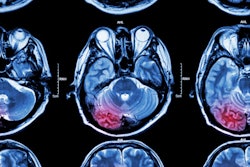
Researchers found that a short, biparametric MRI protocol without contrast was able to find twice as many clinically significant prostate cancers compared with prostate-specific antigen (PSA) testing in a study published February 11 in JAMA Oncology.
The results highlight the promise of biparametric MRI as an alternative to multiparametric MRI as an option for population-based screening for prostate cancer, wrote a team led by Dr. David Eldred-Evans of Imperial College London in the U.K.
"[Our] findings suggest that a short, noncontrast MRI may have favorable performance characteristics as a community-based screening test," the group wrote.
PSA testing is the traditional way to screen for prostate cancer. Men with elevated PSA levels are often sent on for additional testing, such as multiparametric MRI, which has good accuracy for detecting the presence of cancer.
As an alternative to multiparametric MRI, biparametric MRI (bpMRI) protocols -- which take about 15 minutes and don't use contrast, versus 30-40 minutes with contrast for multiparametric MRI -- translate into shorter scanning times and do not expose patients to gadolinium. The potential of biparametric MRI intrigues researchers, as does ultrasound, which is an inexpensive and widely available modality.
The use of either of these modalities for prostate cancer screening hasn't been fully explored, however. To this end, Eldred-Evers and colleagues sought to compare the efficacy of PSA testing to bpMRI and ultrasound for prostate cancer screening using data from the Imperial Prostate 1 Prostate Cancer Screening Trial (IP1 PROSTAGRAM).
The trial included information from seven primary care practices and two imaging centers in the U.K. at which 408 men were screened for prostate cancer between October 2018 to May 2019. All study participants underwent screening with a PSA test, a 15-minute noncontrast bpMRI exam (T2-weighted and diffusion), and an ultrasound exam (B-mode and shear-wave elastography).
PSA test results equal to or greater than 3 µg/L were considered positive, while imaging tests were categorized on a five-point scale for suspicion of prostate cancer, with scores of 3 to 5 on biparametric MRI and scores of 4 to 5 on ultrasound considered positive. Any positive results were further investigated via biopsy. Clinically significant cancers were those with a Gleason score of 7 or higher (typical range, 6 to 10, with 6 being low grade, 7 intermediate, and 8 to 10 high grade).
Biparametric MRI exams scored between 3 and 5 delivered more positive results compared with the PSA test (72 vs. 40), as did ultrasound exams scored between 3 and 5 (96 vs. 40); both of these results were statistically significant. However, bpMRI and ultrasound exams scored between 4 and 5 demonstrated a similar number of positive exams compared with the PSA test (43 vs. 40 for MRI, 42 vs. 40 for ultrasound); these results were not statistically significant.
Biparametric MRI exams with scores of 3 to 5 identified twice as many clinically significant cancers compared to PSA testing, as did bpMRI exams with scores of 4 to 5. MRI's rate of identification of what turned out to be clinically insignificant cancers (overdiagnosis) was comparable to PSA testing, but the ultrasound rate was almost double.
| Positive results for prostate cancer by biparametric MRI, ultrasound, and PSA testing | |||||
| Metric | PSA (≥3 µg/L) | Biparametric MRI score 3-5 | Biparametric MRI score 4-5 | Ultrasound score 3-5 | Ultrasound score 4-5 |
| Positive test | 40 | 72 | 43 | 96 | 52 |
| Biopsy result, significant cancer | 7 | 14 | 11 | 9 | 4 |
| Biopsy result, insignificant cancer | 6 | 7 | 5 | 13 | 7 |
The study establishes a foundation for further research on using imaging for population-based prostate cancer screening, wrote Dr. Susanna Lee, PhD, and colleague Dr. Aileen O'Shea in an accompanying editorial. Both are from Massachusetts General Hospital in Boston.
"In our continued endeavors to decrease the morbidity and mortality of prostate cancer, it is now apparent that MRI will play an important role," Lee and O'Shea wrote. "[Eldred-Evans and colleagues'] ... findings clearly point to prostate MRI as a promising screening test."




.fFmgij6Hin.png?auto=compress%2Cformat&fit=crop&h=100&q=70&w=100)




.fFmgij6Hin.png?auto=compress%2Cformat&fit=crop&h=167&q=70&w=250)











